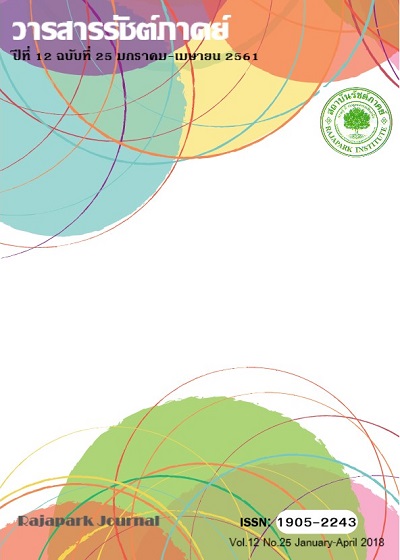Plant Location Decision with Analytic Hierarchy Process
Main Article Content
Abstract
The objective of this research is to propose method for plant location decision with Analytic Hierarchy Process (AHP). The AHP is applied to case study of plant location decision for cassava processing plant. With AHP, the plant location decision in this case study is analyzed with the four-step approach of AHP. For the first step, this decision problem is broken down into Hierarchy of Interrelated Elements with four levels. The 1st level is the goal level that is the good location for cassava processing plant. The 2nd level is the main factor level that are Monetary factors and Non-monetary factors. The 3rd level is the sub factor level that consists of two sub factors (Initial cost and Annual cost) for Monetary factors and six sub factors (Material availability, Utility system, Labor availability, Community attitude, Marketing advantage and Land advantage) for Non-monetary factors. The 4th level is the alternative level that are Land in Nakhon-Ratchasima, Land in Kalasin and Land in Rayong. For the second step, a group of decision makers carefully gives decision data with a pair-wise comparison technique. For the third step, all decision data from the second step are transferred into the weight of each factor. For the last step, the weight of each alternative land is calculated under the goal level and the good location for cassava procession plant can be systematically selected. Finally, the calculation results show that the land in Nakhon-Ratchasima is the good location for cassava procession plant.
Article Details

This work is licensed under a Creative Commons Attribution-NonCommercial-NoDerivatives 4.0 International License.
Views and opinions appearing in the Journal it is the responsibility of the author of the article, and does not constitute the view and responsibility of the editorial team.
References
เทอดธิดา ทิพย์รัตน์ (2013). การบริหารความเสี่ยงในห่วงโซ่อุปทานของการดำเนินงานด้านการเงินภายในของมหาวิทยาลัยสงขลานครินทร์. วารสารมนุษยศาสตร์และสังคมศาสตร์ มหาวิทยาลัยพะเยา, 1(1), 39 -51.
ธรา อั่งสกุล และ จิติมนต์ อั่งสกุล (2014). ระบบแนะนำสถานที่ท่องเที่ยวรายบุคคลโดยใช้เทคนิคการจัดกลุ่มและกระบวนการลำดับชั้นเชิงวิเคราะห์. วารสารเทคโนโลยีสุรนารี, 8(2), 87 -109.
นรินทร์ เอื้อศิริวรรณ และคณะ (2017). การกำหนดหลักเกณฑ์คัดเลือกตำแหน่งที่เหมาะสม สำหรับการจัดตั้งสถานีตรวจสอบน้ำหนักโดยการใช้ทฤษฎีกระบวนการลำดับชั้นเชิงวิเคราะห์ (AHP). วิศวกรรมสารเกษมบัณฑิต, 7(1), 17-33.
นิธิเดช คูหาทองสัมฤทธิ์ (2017). การเลือกเส้นทางการขนส่งสินค้าที่เหมาะสม โดยการวิเคราะห์ การตัดสินใจแบบหลายหลักเกณฑ์. วารสารวิชาการและวิจัย มทร.พระนคร, 11(1), 137-149.
Alan C. Bren. et.al. (2007). Application of the analytical hierarchy process to establish health care waste management systems that minimise infection risks in developing countries. European Journal of Operational Research, 181(1), 403-424.
Matthew J. Liberatore (1987). An extension of the analytic hierarchy process for industrial R&D project selection and resource allocation. IEEE Transactions on Engineering Management, EM-34(1), 12-18.
Metin Dağdeviren., & İhsan Yksel. (2008). Developing a fuzzy analytic hierarchy process (AHP) model for behavior-based safety management. Information Sciences, 178(6), 1717-1733.
Mikko Kurttila. et al. (2000). Utilizing the analytic hierarchy process (AHP) in SWOT analysis a hybrid method and its application to a forest-certification case. Forest Policy and Economics, 1(1), 41-52.
Robert Handfield. et al. (2002). Applying environmental criteria to supplier assessment: A study in the application of the Analytical Hierarchy Process. European Journal of Operational Research, 141(1), 70-87.
Younghwa Lee. et al. (2006). Investigating the effect of website quality on e-business success: An analytic hierarchy process (AHP) approach. Decision Support Systems, 42(3), 1383-1401.


